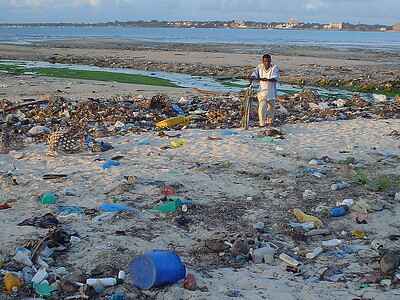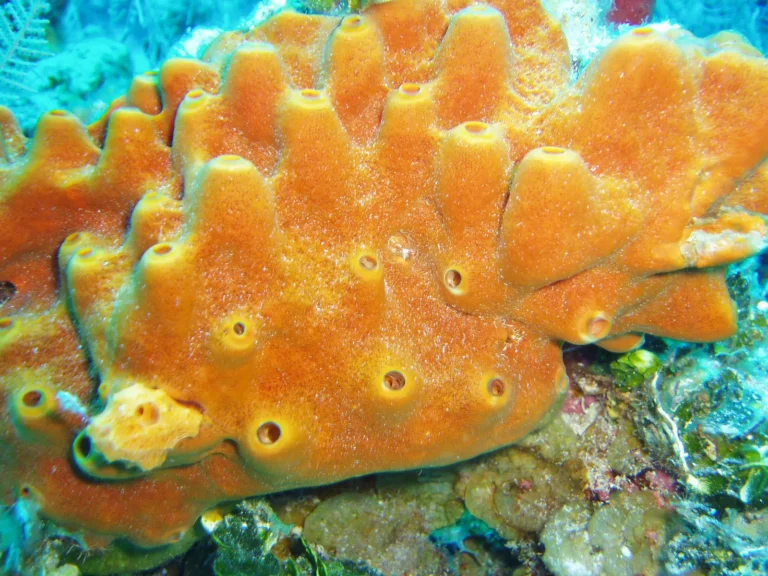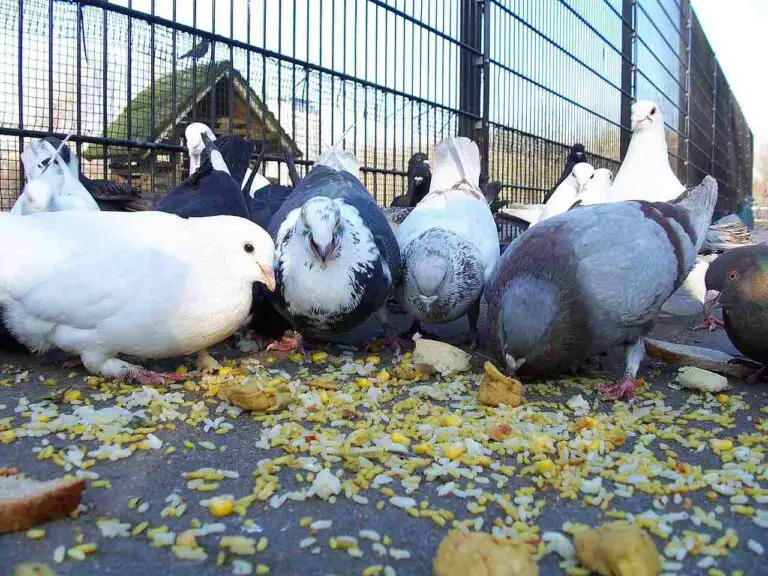7 Examples of Water Pollution from Various Sources and Causes
Examples of water pollution are; urban stormwater-flooding of aquatic ecosystems, untreated effluent-marine discharge, groundwater degradation by landfill leachate, plastic pollution of marine ecosystem, eutrophication by chemical fertilizer-runoff, unsustainable nuclear waste heat-dissipation, and maritime oil tank-leakage.
This article discusses examples of water pollution from various sources and causes, as follows;
1). Urban Stormwater-Flooding of Aquatic Ecosystem (as one of the Examples of Water Pollution)
Stormwater is used to refer to large volumes of water that accumulate in a given area as a result of precipitation, and is a major cause of flooding in urban areas.
In addition to flooding, stormwater is one of the causes of water pollution in urban areas, because of its tendency to carry and transport various foreign materials in its currents as it flows.
This phenomenon of foreign material-assimilation and transport is called stormwater pollution, and it can be seen as a preliminary form of water pollution that leads to further pollution on a larger-scale, when the polluted stormwater is allowed to flow into other water bodies.
Sources of pollutants in stormwater include waste dump-sites like landfills, sewage facilities, industries, and agricultural lands.
The pollutants in urban runoff include sewage, microbial organisms, sediments, pesticides, fertilizers, plastics, and volatile organic compounds (VOCs) among others.
This means that stormwater pollution can encompass other types of water pollution like chemical and organic pollutions; and can be discussed in various contexts including landfilling and waste management, groundwater protection and plastic pollution.
Stormwater causes pollution to local water sources by transporting potentially-harmful materials like pesticides, microbes and fertilizer from urban areas, into these sources which could be natural or artificial.
The issue of water pollution by stormwater flooding is a major one in many parts of the world.
It is linked to water-resource depletion and scarcity [10], and is worsened by other environmental problems and socioeconomic issues like climate change and urbanization [8].
One of the measures taken to address this form of water pollution is the construction of civil structures for water management, such as water dams and urban creeks, which help control stormwater flow, to mitigate flooding and large-scale degradation [7].
Effects of urban stormwater-flooding on aquatic ecosystems can be severe, for both marine and freshwater bodies. Decline in species richness, biodiversity, and general role of the aquatic ecosystem as a carbon sink and nutrient-recycling medium, are all potential outcomes.

2). Untreated Effluent-Marine Discharge
Untreated effluent is simply wastewater from industrial and domestic facilities that is yet to be subjected to any process that reduces its pollutant concentration.
If wastewater is left untreated, what happens is usually a buildup of microbial organisms and thermal energy that facilitate reactions which yield byproducts that increase the toxicity of the fluid. This can easily occur with sewage sludge.
Problems that can be caused by discharge of untreated wastewater into marine and freshwater bodies include; decrease in oxygen levels and loss of biodiversity, as well as eutrophication and other environmental impacts like greenhouse emissions, aesthetic and air pollution.
Untreated sewage is the major cause of water pollution in many areas as a result of shortcomings in infrastructure provision and management; and in the development and enforcement of environmental regulations.
Fecal matter in sewage can breed viruses and bacteria, as well as hazardous biodegradation products that are a threat to public health [13] [3].
Effluents from industrial facilities, when discharged without treatment, may also deposit large amounts of toxins in water bodies.
3). Groundwater Degradation by Landfill Leachate (as one of the Examples of Water Pollution)
A landfill impacts groundwater quality in a negative manner, if the landfill is not well-engineered so that its waste content is effectively isolated from the environment. The process whereby landfills cause groundwater quality to reduce is called leachate pollution.
Leachate pollution is the percolation of toxic fluids produced during waste biodegradation, into soil and water, with resultant deposition of pollutants like heavy metals and microbes.
Landfills and leachate pollution are co-occurrent phenomena because landfills have large deposits of waste that can decompose to form leachate fluid, especially when water is supplied by precipitation.
The amount of leachate formed in any given landfill is proportional to the scale and rate of decomposition [12], which is influenced by physicochemical conditions of the environment including humidity and temperature; as well as by the proportion of organic biomass that occurs as waste in the landfill.
In areas where landfills occur, leachate is a major cause of pollution of both groundwater and surface water resources [1], if there are no equipment to collect, treat and dispose such leachate in a manner that is safe for the environment.
The effects of leachate on groundwater include color and odor changes, ambient temperature change, and high concentrations of potentially-toxic elements and compounds.
With leachate being produced from waste, it is not generally recommendable to use groundwater from aquifers that coincide vertically with landfills (that is; are vertically opposite landfills that are above them and above the ground). This is because such aquifers contain water that is likely contaminated by leachate [9].
Leachate pollution of groundwater is a difficult environmental problem to solve, and often requires complex remediation approaches [2].
4). Plastic Pollution of Marine Ecosystem
Plastic pollution in the ocean is called marine plastic pollution, or marine microplastic pollution.
The entry of plastics into marine ecosystems can be traced to human activities including manufacturing, packaging, and improper waste management.
Plastic pollutes the ocean in several ways, including a poor aesthetic effect, toxin contamination, and microplastics that form by the physical (and chemical) disintegration of larger plastics.
The scale of plastic pollution in the world's oceans in enormous, and reaches several trillions of tons and particles of plastic waste [11]. This becomes more severe in most areas each year, with increasing commercial production and consumption.
Aquatic organisms including marine plants and animals are among those most affected by plastic pollution through various means including poisoning and suffocation.

5). Eutrophication by Chemical Fertilizer-Runoff (as one of the Examples of Water Pollution)
One of the ways in which fertilizer affects the environment is by causing water pollution.
Fertilizers cause water pollution because they enrich water bodies with excessive nutrients that stimulate unnaturally-rapid growth of algae and other microbial organisms that can deposit toxins, and consume dissolved oxygen to an extent that makes the water unsuitable for human use and unfit for organic sustenance.
The process described may be referred to simply as eutrophication.
Fertilizers lead to eutrophication and water pollution when they are used in excessive quantity on agricultural land, so that precipitation and erosion processes cause them to be leached and transported from the soil into water bodies.
Eutrophication can be a very severe problem in some types of aquatic ecosystems including lentic water bodies like lakes and ponds; which have limited flow and water-volume. In such water bodies, fertilizer nutrients can accumulate in very high concentrations with minimal dilution over time.
In some studies, eutrophication has been performed deliberately to observe its influence on primary productivity and aquatic food chains [4].
6). Unsustainable Nuclear Waste-Heat Dissipation
Thermal pollution and nuclear pollution are two different forms of environmental degradation that can be caused by nuclear waste.
Nuclear waste causes pollution by depositing thermal energy and/or radioactive materials into a given medium to an extent that becomes unsafe and potentially-hazardous.
Thermal water pollution is a form of water pollution that involves notable changes in ambient temperature.
Power plants cause thermal water pollution because of the waste heat energy that is released from these facilities. As a matter of fact, all power plants that use thermal energy to generate electricity can cause thermal water pollution; including coal, natural gas, and biomass power plants.
In the same vein, industrial facilities of all kind that utilize thermal processes on a significant scale, can cause thermal pollution.
Thermal water pollution mostly occurs when water from nearby reserves (natural or artificial) is used as coolant for generators and steam turbine engine components.
In such cases, when the water is returned to its source, it is usually of altered temperature and can warm or cool some sections of the water body through conductive, convective and radiant energy transfer.
Thermal pollution of water bodies can change the concentration of important nutrients and gases like oxygen, while making the water unsuitable for various species which either migrate or shrink in population size.
A viable solution to this problem is to adopt a closed-system model of thermal engineering systems, which uses active internal recycling to ensure that working fluids stay within the system without significant exchange of heat or mass with the external environment.
For nuclear power plants, thermal pollution remains one of the biggest environmental challenges to be addressed [6]. It (thermal pollution) is one of the strong points of argument that have been used to counter the ideology that nuclear power is clean.

7). Maritime Oil Tank-Leakage (as one of the Examples of Water Pollution)
Types of pollution caused by by leakage of oil tankers include soil, water and air pollution.
Water pollution involving oil spills from tankers can be very severe, as it poses multiple risks to humans, aquatic organisms, and all other biotic and abiotic components of the ecosystem.
Oil leakage causes water pollution by introducing petroleum fluids and compounds like VOCs (volatile organic compounds) into water bodies. The effects of oil leaks in water include oxygen depletion by coverage of the water surface with a film of oil, toxin accumulation, and contamination of soil on the ocean floor, coastline and adjacent wetlands.
Like groundwater pollution, oil spill remediation can be complex and challenging, especially in cases that involve large volumes of oil. It is also disadvantages for its economic ripple effects [5], ranging from the obvious loss of energy resources to the loss of productivity for ocean-dependent industries like tourism, transport and agriculture.

Conclusion
Examples of water pollution are;
1. Urban Stormwater-Flooding of Aquatic Ecosystem
2. Untreated Effluent-Marine Discharge
3. Groundwater Degradation by Landfill Leachate
4. Plastic Pollution of Marine Ecosystem
5. Eutrophication by Chemical Fertilizer-Runoff
6. Unsustainable Nuclear Waste-Heat Dissipation
7. Maritime Oil Tank-Leakage
References
1). Abd El-Salam, M. M.; Abu-Zuid, I. G. (2015). "Impact of landfill leachate on the groundwater quality: A case study in Egypt." J Adv Res. 2015 Jul;6(4):579-86. Available at: https://doi.org/10.1016/j.jare.2014.02.003. (Accessed 27 April 2023).
2). Abiriga, D.; Jenkins, A.; Vestgarden, L. S.; Klempe, H. (2021). "A nature-based solution to a landfill-leachate contamination of a confined aquifer." Sci Rep. 2021 Jul 21;11(1):14896. Available at: https://doi.org/10.1038/s41598-021-94041-7. (Accessed 27 April 2023).
3). Bhat, S.; Qayoom, U. (2021). "Implications of Sewage Discharge on Freshwater Ecosystems." Sewage - Recent Advances, New Perspectives and Applications. Available at: https://doi.org/10.5772/intechopen.100770. (Accessed 27 April 2023).
4). Chislock, M. F.; Doster, E.; Zitomer, R.; Wilson, A. E. (2013). "Eutrophication: Causes, consequences, and controls in aquatic ecosystems." Available at: https://www.nature.com/scitable/knowledge/library/eutrophication-causes-consequences-and-controls-in-aquatic-102364466/. (Accessed 27 April 2023).
5). Galieriková, A.; Materna, M. (2020). "World Seaborne Trade with Oil: One of Main Cause for Oil Spills?" Transportation Research Procedia 44:297-304. Available at: https://doi.org/10.1016/j.trpro.2020.02.039. (Accessed 27 April 2023).
6). Huang, F.; Lin, J.; Zheng, B. (2019). "Effects of Thermal Discharge from Coastal Nuclear Power Plants and Thermal Power Plants on the Thermocline Characteristics in Sea Areas with Different Tidal Dynamics." Water 11(12):2577. Available at: https://doi.org/10.3390/w11122577. (Accessed 27 April 2023).
7). Lee, G. F.; Jones-Lee, A. (2005). "Urban Stormwater Runoff Water Quality Issues." Water Encyclopedia. Available at: https://doi.org/10.1002/047147844X.sw1602. (Accessed 27 April 2023).
8). Miller, J.; Hutchins, M. (2017). "The impacts of urbanisation and climate change on urban flooding and urban water quality: A review of the evidence concerning the United Kingdom." Journal of Hydrology: Regional Studies 12(C):345-362. Available at: https://doi.org/10.1016/j.ejrh.2017.06.006. (Accessed 27 April 2023).
9). Nagarajan, R.; Thirumalaisamy, S.; Lakshumanan, E. (2012). "Impact of leachate on groundwater pollution due to non-engineered municipal solid waste landfill sites of erode city, Tamil Nadu, India." Iranian J Environ Health Sci Eng. 2012 Dec 27;9(1):35. Available at: https://doi.org/10.1186/1735-2746-9-35. (Accessed 27 April 2023).
10). Nguyen, H-Q.; Radhakrishnan, M.; Huynh, N.; Salingay, M. L. B.; van der Steen, P.; Pathirana, A. (2017). "Water Quality Dynamics of Urban Water Bodies During Flooding in Can Tho City, Vietnam." Available at: https://doi.org/10.20944/preprints201703.0229.v1. (Accessed 27 April 2023).
11). Paddison, L. (2023). "More than 170 trillion plastic particles found in the ocean as pollution reaches ‘unprecedented’ levels." Available at: https://edition.cnn.com/2023/03/08/world/ocean-plastic-pollution-climate-intl/index.html. (Accessed 27 April 2023).
12). Raju, M. V. S. (2013). "Contamination of Ground Water Due To Landfill Leachate." International Journal of Engineering Research 33(5):385-392. Available at: https://www.researchgate.net/publication/290305959_Contamination_of_Ground_Water_Due_To_Landfill_Leachate. (Accessed 27 April 2023).
13). Wear, S.; Acuña, V.; McDonald, R.; Font, C. (2021). "Sewage pollution, declining ecosystem health, and cross-sector collaboration." Biological Conservation 255(5):109010. Available at: https://doi.org/10.1016/j.biocon.2021.109010. (Accessed 27 April 2023).





